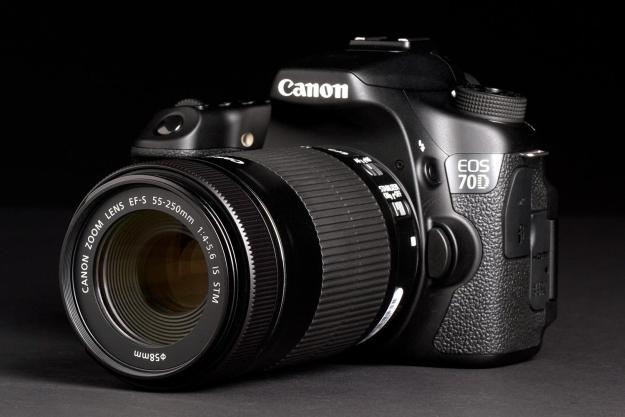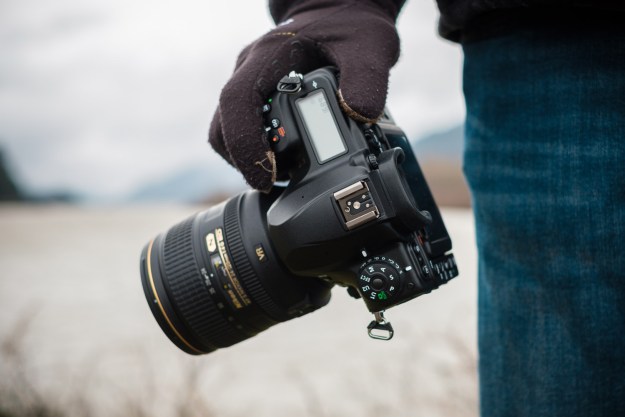
“In addition to great stills and videos, Canon’s new Dual Pixel AF technology is a real winner, garnering the EOS 70D an Editor’s Choice Award.”
- Excellent enthusiast DSLR
- Dual Pixel AF for movies a major improvement
- High-quality stills, great videos
- No AF Assist lamp on body
- Wi-Fi implementation needs help
- Bulky, but that comes with the territory
Given the maelstrom in the camera business, Canon – still the biggest player – is keeping a decided low profile while sticking to DSLRs, one of its main meal tickets. The 20.2-megapixel EOS 70D ($1,199, body only) is the latest and it’s targeted to advanced photographers and budding moviemakers. From a company that knows how to make very good DSLRs, we expected the 70D to take great photos. But it’s the new Dual Pixel AF technology and moviemaking prowess that won us over.
Features and design
We’ve tested many cameras lately but most have been mirrorless models and advanced compacts with larger sensors. So when we put our hands on an “old-school” DSLR like the 70D, it’s a bit of a shock handling it, as it’s much heavier and bulkier than those aforementioned camera types. But in return you get a camera loaded with everything an advanced photographer could want, including the new Dual Pixel AF system for more accurate focusing in Live View, which is especially helpful when shooting videos. In fact, the 70D is one of the better movie-making DSLRs, getting close to one of our favorites, Sony’s Translucent Mirror Technology editions like the Alpha A77; the mirrorless Alpha A7s aren’t too shabby either.
At close to 27 ounces with just the battery – without a lens – the 70D is no lightweight, and measuring 5.5 x 4.1 x 3.1 inches, it’s not small either. Yet the size and weight offer definite pluses compared to mirrorless Compact System Cameras. Along with a full selection of handy keys/buttons, the camera has a potent battery that’s rated at 800 shots, far more than any CSC. Granted you’ll get a workout handling the 70D but for many, it’s well worth it.
There’s nothing new or unusual about the design of the camera; it’s very comforting and familiar with its textured black body and substantial grip. The key feature on the front is the EF mount that accepts 103 different lenses – far more than any CSC. Whatever your artistic vision or budget, the company has the glass for it. We were supplied a 55-250mm f/4-5.6 IS STM zoom for our review, which is silent when you’re shooting movies – an excellent feature. Also on the front is a red-eye reduction/self-timer lamp. Canon continues to place the AF Assist lamp in the flash rather than on the body like Nikon. So you have to manually pop open the flash to enable this function, and the light can be intense. The 70D has a 19-point AF system (all cross type) that grabs focus very quickly, so the AF Assist isn’t that big of an issue. It’s far from a deal breaker, just a Canon quirk.

The rear is dominated by the 3-inch vari-angle, touch-enabled LCD rated 1,040k dots. You have a much greater variety of angles than the more common tilt-only displays. Quality is quite good and there are few issues with reflectivity. The optical viewfinder is also top notch with 98-percent coverage. An easily accessible diopter control makes it easy to adjust for your eyesight. Given the large amount of real estate due to the camera size, there are additional buttons including Menu, Info, Live View, AF-On, AF Point Selector, AE-/FE-Lock, Q (Quick Menu), Playback, Delete and MultiFunction Lock. A Control Dial with center Set button rounds out the extensive collection. DSLR fans will not be disappointed and those moving up from an entry-level DSLR shouldn’t be put off.
On the right side is the SD card compartment, while on the left are remote and mic inputs, mini HDMI and AV outs, plus the speaker. The bottom is the tripod mount and battery compartment.
What’s in the box
The 70D arrives with the body, battery, plug-in wall charger, strap, USB cable, and two printed instruction manuals. There’s a short one (36 pages) for handling Wi-Fi and another 164-page booklet that’s an in-depth instruction manual. You also get a disc with the Canon Software Solutions package for handling images and developing RAW files. Of course, you’ll need to purchase a lens or three and a high-speed, high-capacity SD card to complete the package.
Performance and use
We used the 70D with the stabilized 55-250mm zoom for a good stretch, shooting a wide variety of subjects ranging from touristy train rides, Sedona mountains, and strolls through desert gardens. Even with the long lens, the camera had a nice balance and the combination of a good grip and textured surface made it feel comfortable, even with all the bulk. It’s definitely a commitment walking around with this baby compared to the recently reviewed Sony Alpha A7 and A7R but in many ways using a DSLR felt like putting on a pair of comfy running shoes and hitting the pavement. Good stuff.
Canon can still make a standout DSLR for a reasonable amount of money.
Along with the 70D’s 20.2-megapixel APS-C sensor, the DIGIC 5+ processor keeps things very responsive and alive. The camera has a top burst mode of 7 frames per second. Combining it with the 19-point AF makes it a good choice for action shooters. Also adding to a nice list of performance features is Dual Pixel AF for faster focusing during Live View. DT readers know our complaints with DSLR video regarding the slow focus, rolling shutter, and moiré. With Dual Pixel AF Canon claims “camcorder-like video,” meaning point-and-shoot focusing that’s accurate and brainless. Based on our tests it’s not as good as a top-shelf camcorder but miles ahead of where Canon used to be and gets close to Sony, the current champ in this area. Although focusing has made vast improvements, Canon still has to step up its game since top resolution is 1080/30p versus Sony’s 1080/60p. Hopefully this will be rectified with the next EOS release. Even with this carping it shouldn’t take away from the big technological leap forward and video quality that’s quite good. Aspiring directors should lean toward this DSLR if that’s a critical consideration; the stills aren’t shabby either.
For most of your still work, you’ll use the main mode dial before drilling down into Canon’s classic menu system. On the dial you’ll find the usual settings including Scene Intelligent (Smart) Auto, PASM, Bulb, Custom, Scene (9 options), Creative Auto, and Flash Off. Go into Live View, tap the Q button, and you can use the touchscreen to make various adjustments, depending on the setting. You can tap-to-focus and tap-to-shutter as well. It’s clean and simple to use. Since this is an old-school DSLR, we primarily used the optical viewfinder for stills and naturally the 3-inch monitor for Live View videos. The camera was set to top resolution and then it was off to town.

We’ll repeat – movie quality is very good, close to a mainstream camcorder. We love the fact you can concentrate on framing your clips rather than dealing with finger contortions to keep accurate focus as is the case with most other DSLRs. We’d also urge anyone purchasing this camera to opt for Canon zoom lenses labeled STM (Stepping Motor) so the mics only pic up ambient sound and conversations rather than the noise of the zooming lens; this is incredibly annoying with quiet scenes. Canon gets really high marks for Dual Pixel AF and is a major achievement.
And there’s a reason Canon maintains its number-one rank among DSLR sellers – the company makes very good ones ranging from the affordable, compact SL1 to the gigantic, ultra-expensive EOS-1D X. We mentioned earlier shooting with the 70D was like putting on a pair of comfy running shoes and gliding through the streets. The camera is a smooth operator – response is good, focusing is fast, shutter speed hits 1/8000th, usability is simple, and image quality is excellent. There’s really not much you can ask for other than a full-frame sensor but for $1,199, APS-C is what you’ll get. That said only the fussiest pixel peeper will squawk about these 20.2-megapixel images. We enlarged them 100 percent on a 27-inch monitor and very much liked what we saw (see samples).
Movie quality is very good, close to a mainstream camcorder.
We mentioned how good the response is yet there were certain instances where the camera did not live up to expectations. As we traveled through the Verde Canyon, a bald eagle flew by. Now, asking a 55-200mm lens – even at 7 fps – to grab it might be asking too much but the bird we “shot” wasn’t super sharp. So much for that Nat Geo cover! Yet the vast majority of times we got our keepers. For all its faults dealing with the rapidly changing marketplace, Canon can still make a standout DSLR for a reasonable amount of money.
The EOS 70D has built-in Wi-Fi and downloading the EOS Remote app to our Droid 4 was easy. Once you go through entering the SSID hoops and pairing the camera and your smartphone, you can share away. The app lets you control the camera remotely, transfer images to another Canon camera, print using a Wi-Fi-enabled printer, as well as accessing Canon’s Image Gateway online portal for more saving and sharing. We had issues linking the 70D and our phone but with some fiddling we got it to work. In terms of ease of use, this system is back of the pack. Can we make a suggestion to Canon execs? Just put out an ad and ask a couple of college kids to design the software. It’ll be done in a fraction of the time and you won’t need 30-plus pages to explain how to make it work.

Conclusion
The Canon EOS 70D is a first-rate 20.2MP DSLR and gives one of our favorites, the Nikon D7100, a very good run for the money. We really like the operability and still quality of both. However, the Canon really trumps Nikon on the video front. Canon’s new Dual Pixel AF technology is a real winner. Given its combined still and video results, the 70D gets our Editor’s Choice Award. But Canon please do something with that Wi-Fi software.
Highs
- Excellent enthusiast DSLR
- Dual Pixel AF for movies a major improvement
- High-quality stills, great videos
Lows
- No AF Assist lamp on body
- Wi-Fi implementation needs help
- Bulky, but that comes with the territory
Editors' Recommendations
- The best photography tripods
- Debunked: Canon is not recalling or delaying shipments of the EOS R5
- Nikon’s flagship and very pricey D6 camera finally starts shipping
- The best Canon cameras
- Nikon D750 vs. D780: 5 years in the making, Nikon’s newest proves its worth









